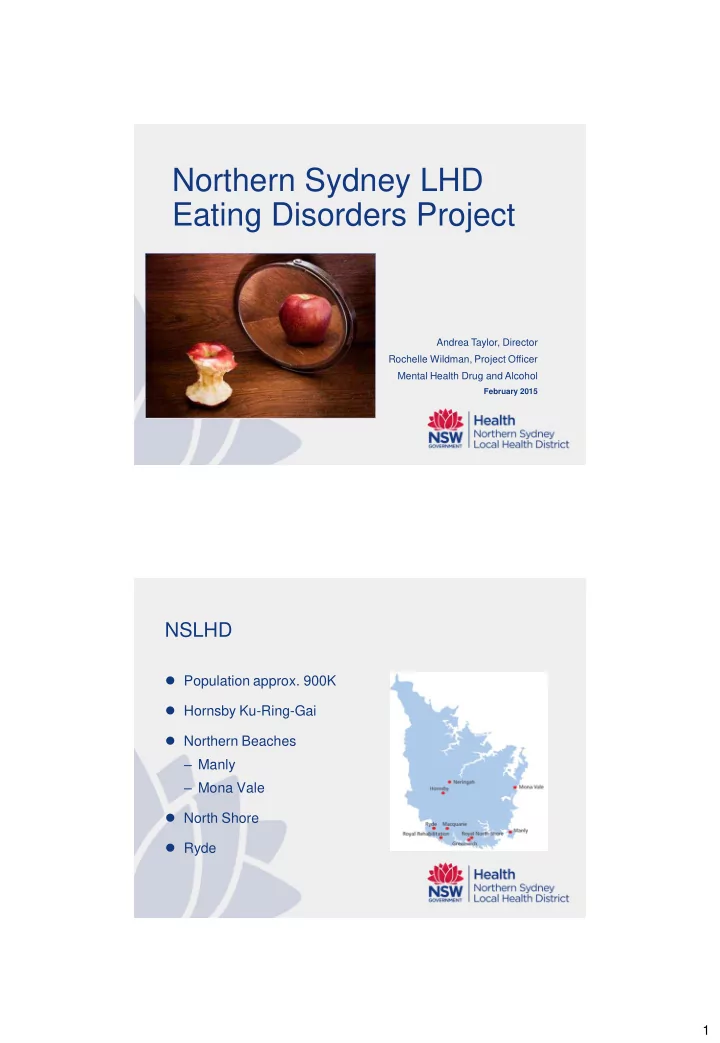

Northern Sydney LHD Eating Disorders Project Andrea Taylor, Director Rochelle Wildman, Project Officer Mental Health Drug and Alcohol February 2015 NSLHD Population approx. 900K Hornsby Ku-Ring-Gai Northern Beaches – Manly – Mona Vale North Shore Ryde 1
Background NSLHD Clinical Services Plan Executive Sponsor appointed by CE NSLHD NSLHD Clinical Redesign Project for Eating Disorders initiated late 2012 Engaged NSLHD Planning Team Steering Committee through EOI and partnerships Workshop Feb 2013 and further workshops in 2014 Clinical Reference Group est. then merged with cttee NSW Service Plan for Eating Disorders 2013 - 2018 released in September 2013 Draft NSLHD Eating Disorders Plan and training Sub Plan developed Promotion, promotion and more promotion EOI for Conference Attendance What we knew No public eating disorders services in NSLHD Periodic adverse media coverage about lack of services NSLHD Planning Unit data: – NSLHD residents use 37% of Eating Disorders Services in NSW [aggregated public and private data] – NSLHD residents have a high utilisation of private health services. 2
Separations by NSLHD hospital – primary and secondary diagnosis NSLHDA Admissions by primary and secondary diagnosis 3
Blue = single admission Other colours = multiple admissions Number = LOS Blue = single admission Other colours = multiple admissions Number = LOS 4
LOS by diagnosis What does our customer profile look like? NSLHD File Audit 124 admissions for 2012-2013 Audit Tool was developed by the Steering Committee and Clinical Reference Group Collected info on: – History – Current Diagnosis – BMI on admission/discharge – Clinical staff involved in care – Legal status – Discharge plan – Individual Patient Specialling 5
File Audit results Patients were cared for in 22 different wards across NSLHD: – Psychiatric inpatient units – usually PECC – Physical inpatients units – usually EMU, MAU, General Medical Ward Lack of a coordinated approach to care Skill base of clinicians variable Documentation varied Consistency of diagnosis 15 admissions accounted for 50% of NSLHD bed days Cost of care was variable Clinical Stakeholder Consultation Staff interviews were conducted with clinicians across NSLHD to get a better understanding of the issues Some of the key findings were: – No defined model of care – Generalist services have limited capacity to respond to this patient group effectively – Treating psychiatric or physical issues – not the ED – There is often no treatment plan or coordinated approach – Referral to specialist services can be challenging 6
NSLHD ED Options: LHD Eating Disorders Coordinator LHD Eating Disorders Team -C/L service -Home Ward LHD Eating Disorders Service/s: - Outpatient - Day program - Inpatient Unit Which Option?? Clinical Council acknowledged that: 1.Status quo was unacceptable 2.Coordinator/Consultation Liaison Officer – Alone not viable secondary to limited capacity for clinical care – In Conjunction with a Pop-Up Team 3.ED Consultation Liaison Team a possibility 4.Inpatient Unit not supported by current activity nor under ABF projections 7
Eating Disorders Consultation Liaison Officer The proposed role of this position is to: Develop a model including all aspects of governance Establish and Coordinate the Pop-Up Team Implement the NSLHD Eating Disorders Service Plan Provide technical and clinical advice across NSLHD Liaise with state tertiary ED services Develop NSLHD pathways Continue to provide awareness raising, education and training for LHD staff Pop-Up Team will receive specialist training by the CEDD What is a Pop-Up Team? Utilised in Paediatric and Rural and Remote Palliative Care Services Volumes of customers are low and clinical complexity is high Drawing together specific clinical expertise for complex cases , where there are insufficient patient numbers to support a dedicated team that is across medical specialties, divisions and geography under a clinical lead 8
Where are we now… NSLHD Clinical Council have given in principle agreement for the model Working on the Pop-Up Team governance Looking to fund the CL role Added a Clinical Lead (Staff Specialist Psychiatrist, part- time) to the model to enhance Medical engagement NSLHD Eating Disorders Service Plan draft has been developed, includes an Education and Training sub plan 9
Recommend
More recommend